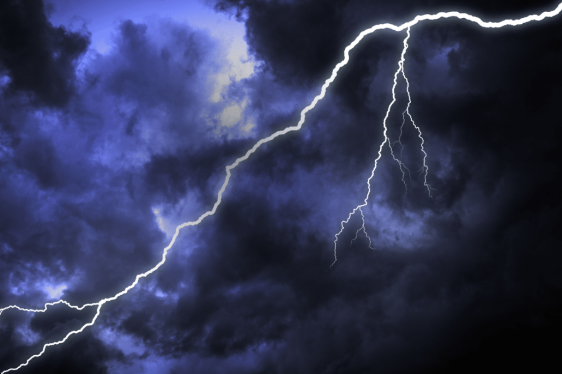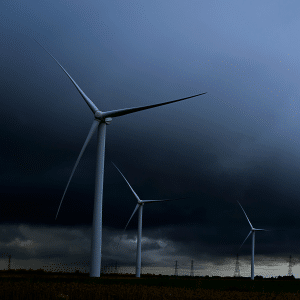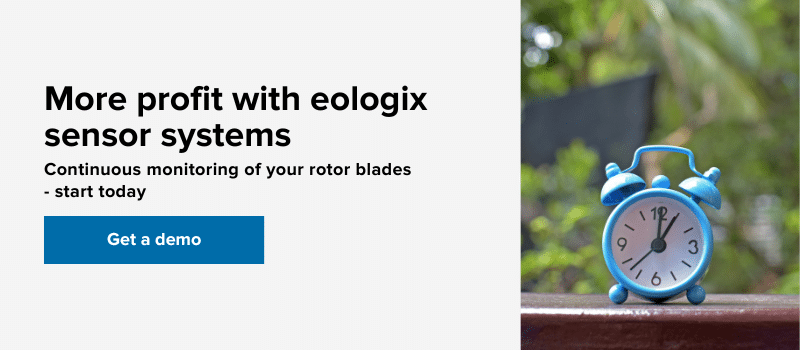TECHNOLOGY | 10 MIN TO READ
Strike back: A 12-step guide after a lightning strike hits a wind turbine

Turbines are exposed to many environmental influences during their operating life – including the force of lightning strikes, which can have costly consequences. According to DNV, lightning damage is even the single largest cause of unplanned downtime in wind turbines and the most common insurance claim filed by wind farm owners.*
Why are wind turbines struck by lightning?
If the rotor blades reach the highest point during their rotation, they may literally attract lightning due to their material properties and height. But not all lightning is the same. During a thunderstorm, two types can occur: so-called downward and upward lightning.
Upward lightning in particular poses an increasing danger to wind turbines due to its more initial continuous current (ICC) lasting approximately much longer than the current of downward lightning. Therefore, upward lightning is the most common weather-related cause of fires or serious damage to rotor blades.**
However, a lightning strike does not always have to lead to a turbine fire. It can also result in minor damage, which is often not recognized until late, while significantly shortening the blade’s service life.
What is the best way to react in the event of a lightning strike?
Are you aware if your turbine was hit?
First and foremost, it’s crucial to swiftly determine whether a wind turbine has been struck by lightning. One effective method is through our Lightning Monitor, which provides real-time notifications via email, ensuring you’re promptly informed of any lightning strikes affecting your assets.
A soon as you really know that your turbine got struck by lightning the following steps can be important for you.

Read more about our lightning detection system.
Are you interested in this topic and were unable to attend our webinar? Take the opportunity and get the recording.
12 important steps after a lightning strike
Upon confirmation of a lightning strike on your turbine, swift and comprehensive action becomes imperative to mitigate damage and uphold the safety and reliability of your renewable energy infrastructure. In this extensive guide, we’ll delineate steps to undertake post-lightning strike, ranging from safety prioritization to insurance claim navigation and implementation of preventive measures for future incidents.
It’s important to note that the extent of these actions may vary depending on the severity of the strike and the specific circumstances of each incident. While we acknowledge that not every operator may follow each of these steps, they serve as a valuable guideline for navigating the aftermath of a lightning strike on wind turbines.
1. Safety first
During thunderstorms with lightning activity, the safety of personnel is paramount. Prioritize safety protocols and ensure that all necessary precautions are taken before approaching the turbine.
2. Shutdown and remote monitoring
If turbines have been struck by lightning or are suspected of being struck, arrange for them to be shut down. Lightning protection systems, such as StrikeTape from Weather Guard Lightning Tech, and rotor blade monitoring systems, such as our acoustic lightning detection (also in combination with acoustic surface damage detection), can protect your blades and provide initial information on the condition of the blade. This step is crucial to prevent further damage and gain initial information (i.e. prioritizing faults).
3. Visual inspection and fire safety
Conduct a visual inspection of the turbine, checking for any visible damage. If there were indications of fire, ensure a detailed inspection to eliminate any potential fire hazards.
4. Data Analysis
Analyze data logs and diagnostic information to gain a comprehensive understanding of the turbine’s performance before, during, and after the lightning strike.
5. Professional inspection and testing
Engage qualified technicians for an in-depth inspection and testing. This step may involve specialized equipment to assess structural integrity, electrical systems, and other critical components.
6. Documentation
Document all findings meticulously, as this documentation is vital for insurance claims. Record visual inspections, data analysis, and details of any repairs or replacements.
7. Insurance claim process
Notify your insurance provider promptly about the incident. Provide them with the documented evidence, including photographs, inspection reports, and any relevant data. Follow their guidance on initiating the claims process.
8. Claims Assessment
Insurance adjusters will assess the damage and work with you to determine the coverage and extent of the claim. Provide them with all requested information promptly to facilitate a smooth claims process.
9. Repair and Maintenance
Proceed with necessary repairs and maintenance, following the guidance of both the insurance adjusters and turbine manufacturer. Ensure that all components are replaced or repaired to restore optimal functionality.
10. Post Repair Testing
Conduct thorough testing after repairs to verify that the turbine is operating at full capacity. This step is crucial for confirming the success of the recovery efforts.
11. Review and Learn
Post-incident, conduct a review to understand the root causes of the lightning strike and assess the effectiveness of the lightning protection system. Implement any necessary improvements to prevent future incidents.
12. Claim Closure and Monitoring
Work closely with the insurance provider to close the claim. Continue monitoring the turbine’s performance to ensure long-term reliability and address any lingering concerns promptly.
By following these systematic steps and maintaining meticulous documentation, wind turbine operators can effectively navigate the aftermath of lightning strikes, ensuring the resilience and sustainability of their renewable energy infrastructure.
Reference:
- * Lightning protection of wind turbines. (o. D.). DNV. https://www.dnv.com/services/lightning-protection-of-wind-turbines-138227
- ** You can read more details in the article by Isabell Stucke, Deborah Morgenstern, Gerhard Diendorfer, Georg J. Mayr, Hannes Pichler, Wolfgang Schulz, Thorsten Simon and Achim Zeileis “Upward Lightning at Wind Turbines: Risk Assessment From Larger-Scale Meteorology“.






